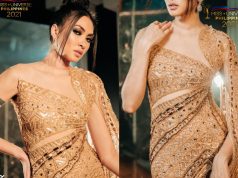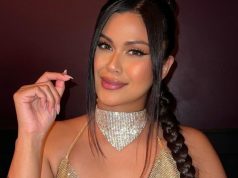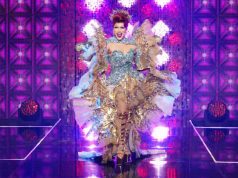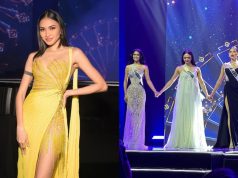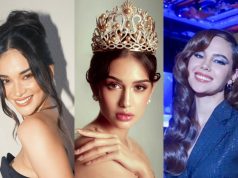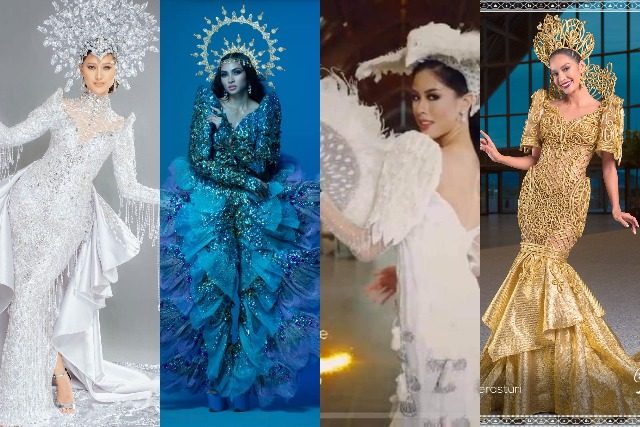
From bangus to a mythical creature, some national costume designs were inspired by different symbols of places Miss Universe Philippines 2021 delegates represent.
A total 28 delegates who showcased their creative outfits on September 23.
Here are some of the highlights during the National Costume round as well as the inspirations behind their ensemble:
Cebu province
Steffi Aberasturi wore a gold ensemble that paid homage to the traditional rattan weaving of Cebuanos.
“As an advocate for empowering small businesses, my costume pays homage to a traditional Cebuano livelihood that’s been more profound during the pandemic – Rattan weaving,” Aberasturi said on Instagram.
It was in Sogod, Cebu that she and her mother were able to meet rattan weavers whose stories inspired her.
Moreover, her outfit also honored the Catholic image of Sto. Niño or the Child Jesus.
“The intricate costume celebrates the 500 years of Christianity in the Philippines by honoring the colors of one of the most well-known religious relics of the Philippines – The Señyor Sto Niño,” Aberasturi said.
The costume was designed by Cebuano Malayka Yamas. Yamas posted behind-the-scene photos and videos of her creation on Facebook.
Cebu City
Cebu city bet Beatrice Luigi Gomez wore a glittery blue pantsuit that was inspired by the mythical beast of Cebu, the moon eater or the bakunawa.
This was explained by Gomez’ designer Axel Que on Facebook.
“One of the most captivating pieces of literature from our rich trove of folkloric history has got to be the tale of the Bakunawa. Each region and tribe might have different iterations of the mythical beast, and its origin story, but one thing is certain, it has been believed to have caused lunar eclipses, earning it’s notorious moniker: Moon Eater,” Que said.
Of the different depictions of the creature, the designer said they went with the most popular image of bakunawa as a colossal sea serpent/dragon for Gomez’ dress.
They also opted for an avant-garde trouser for the bottom that was detailed to mimic the fins of the sea serpent.
To finish off the look, Que stated that they created a double halo headdress “to represent the celestial phenomenon of a lunar eclipse.”
Masbate
Kisses Delavin, Miss Universe Philippines Masbate, wore a white mermaid dress that represented the lapay bird of Masbate, according to designer Polly Lagyap.
On a Facebook post, Lagyap described the lapay as the province’s “most symbolic and culturally distinct bird.”
“The white hovering seagull bird or great-billed heron, is one of the most typical and beautiful scenes in baranggay Bantigue, Masbate,” he said.
Lagyap also explained how the rest of the dress depicted the bird’s grace, feathers and wings.
“Lapay’s softness and finest are represented by its hemline made from ostrich feathers. And Lapay’s greatest treat, its graceful wings are represented by a fans of both hands. Topping of the exquisite and regal creation is a symbolic representation of Lapay itself, elegantly perched on the head of our humble Carnival Queen,” he added.
Pangasinan
The silver costume Maureen Wroblewitz wore was also inspired by an animal, that is, the bangus.
Wroblewitz explained this on a Facebook post. She also thanked the designer Louis Pangilinan for the creation.
“Nestled by the sea and traversed by seven rivers, this National Costume was designed to represent the hardworking fish traders of the Province that thrive amidst the pandemic,” she said.
Wroblewitz also added that the other details of the dress symbolized the fine salt beds of the province.
“The silver beads, crystals, and sequins were hand-embellished as a representation of the rich and fine salt beds of the Province where it was derived and owed — “panag asinan” — where salt is made,” she said.
Taguig
Katrina Dimaranan of Taguig wore an intricately designed lavender costume that represented the “Probinsyudad” title of her hometown.
Dimaranan also thanked designer Val Taguba for the ensemble.
“The construction of the dress is inspired by ‘innovation’ and ‘transformation’ which is a representation of the Probinsyudad of Taguig,” Dimaranan said on Instagram.
“The shoulders are beaded chain accent which is Tito Val’s modern take on traditional butterfly sleeves. Looking closely, the designs are art-deco inspired; the popular design back when Manila’s Carnival Queen was happening as a tribute,” she added.
Iloilo
Kheshapornam Ramachandran of Iloilo wore a black and gold costume that is inspired by the classic gown of the carnival queen of the province, Pura Villanueva Kalaw, according to designer Alfie Desamparado.
In a Facebook post, Desamparado also explained that it is a modern take on the traditional terno with handcrafted embellishments and writings of Graciano Lopez Jaena, who founded La Solidaridad and hails from Iloilo.
“The embellishments are handcrafted to depict the pillars of Molo Church and hand beaded with acrylic stones to paint how Jose Rizal described it as ‘La Iglesia Bonita’ or ‘A Beautiful Church’,” he said.
The headdress, meanwhile, represented some inspiring and empowering women from Iloilo, Desamparado wrote.
These include Pura Kalaw, Teresa Magbanua, Patrocino Gamboa, Miriam Defensor Santiago, and Josette Biyo.
Aklan
The colorful costume of Christelle Abello of Aklan was patterned after the “festival queen” concept of the competition.
It was designed by Ryan Salazar Lopez.
“It was innovated to make it high fashion. The National Costume was made of piña fiber of Aklan, with colorful floral appliques that depicts the vibrancy of our province,” Abello said on Facebook.
“The costume showcases the culture, history and heritage of our country,” she added.





